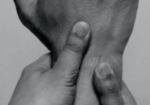Outcomes of Rigid Night Splinting and Activity Modification in the Treatment of Cubital Tunnel Syndrome
Filed under Treatments
Shah, C. M., Calfee, R. P., Gelberman, R. H., & Goldfarb, C. A. (2013). Outcomes of rigid night splinting and activity modification in the treatment of cubital tunnel syndrome (night splint for cubital tunnel syndrome). The Journal of Hand Surgery, 38(6), 1125–1130.e1. https://doi.org/10.1016/j.jhsa.2013.02.039
By: Sophia Grimm
The Skinny:
The purpose of this study was to identify symptom improvement in patients with mild to moderate cubital tunnel syndrome treated with rigid night orthosis and activity modifications. The degree of ulnar nerve dysfunction was identified according to Dellon’s classification.
- Dellon 1: Limited to intermittent paresthesia and weakness
- Dellon 2: Intermittent paresthesia and notable weakness
- Dellon 3 Persistent paresthesia and significant weakness with or without intrinsic muscular atrophy
Current conservative treatment guidelines for cubital tunnel syndrome are nerve gliding exercises, activity modification, and orthotic use. It is also common to use the cubital tunnel syndrome splint.
In the Weeds:
This study included 19 patients with Dellon’s 1 & 2 classification of cubital tunnel syndrome. All patients were treated with a rigid nighttime orthosis holding the elbow at a position of 45 degrees of flexion for 3 months and activity modifications to decrease irritation of the ulnar nerve. Patients were evaluated at enrollment, 6 weeks, 3 months, and 1 year with the QuickDASH, SF-12, grip and pinch strength measurement, presence or absence of Froment’s sign, and strength assessment of the first dorsal interosseous and flexor digitorum profundus to small finger. Researchers also used static 2-point discrimination of the 5th digit to assess for sensory changes, tinel’s at the elbow, evaluated ulnar nerve stability at the cubital tunnel, and assessed for a combined flexion with pressure provocation test by placing the patient’s elbow in maximum flexion and, while in this position, placing pressure on the ulnar nerve just proximal to the cubital tunnel. Electromyography and nerve conduction studies were also performed on all patients.
Bringing it Home:
The researchers found an 88% success rate for treating cubital tunnel syndrome in 21 out of 24 extremities with a rigid 45-degree nighttime orthosis and activity modifications. Both QuickDASH and SF-12 scores showed statistically and clinically significant improvement within 3 months of treatment. The improvements noted at 3 months were maintained at 1-year follow-up.

This study has promising clinical treatment findings for cubital tunnel syndrome. The sample size was small, and the study has not been replicated. All participants were treated with the same intervention and therefore no comparisons could be drawn. However, the subjective and objective data collected matched the findings of the study.
3 Comments
Leave a Comment
More To Read
6 of our Favorite Adaptive Equipment Tools for CMC Osteoarthritis
Individuals struggling with osteoarthritis of the 1st CMC joint usually have difficulty with daily activities and it can become very frustrating. Everyday tasks such as cutting food, opening containers, and donning a button up shirt can become painful and slow. The largest contributor to the overall function of our hand is the thumb. If the…
Read MoreTest for Distal Radial Ulnar Joint of the Wrist
Ballottment Test for Wrist DRUJ Reliability and Validity Analysis of the Distal Radioulnar Joint Ballottement Test Nagashima, M., Omokawa, S., Hasegawa, H., Nakanishi, Y., Kawamura, K., & Tanaka, Y. (2024). Reliability and validity analysis of the distal radioulnar joint ballottement test. The Journal of Hand Surgery, 49(1), 15–22. https://doi.org/10.1016/j.jhsa.2023.10.006 The Skinny: Distal radioulnar joint (DRUJ)…
Read MoreTrigger Finger… Quick and Dirty!
This is for you… Hand Therapists! Stenosing tenosynovitis, otherwise known as trigger finger, is a common condition affecting children and adults of all ages. Fast Facts Trigger finger usually occurs at the A1 pulley It occurs with inflammation of the tendons and sheaths of fds and fdp The digit can lock in both flexion and…
Read MoreWrist Proprioception Ideas for Hand Therapy
Wrist Proprioception Intervention Ideas: By Ammie Ingwaldson Lack of wrist proprioception exercises can affect clients in the hand therapy setting with neurological and musculoskeletal conditions. Proprioception limitations are found in common conditions such as carpal tunnel syndrome, distal radius fracture, and CRPS (Valdes, Naughton & Algar, 2014). Proprioception is necessary during daily tasks to provide…
Read MoreSign-up to Get Updates Straight to Your Inbox!
Sign up with us and we will send you regular blog posts on everything hand therapy, notices every time we upload new videos and tutorials, along with handout, protocols, and other useful information.







Great article! Do you know why the splint is not positioned in full extension, why is it 45 degrees of flexion?
There is no mention of ulnar nerve gliding exercise (flossing) – is there are reason this was not included?
hello,
It was an article review focusing on orthosis fabrication therefore I don’t think it was a study objective of the authors
Miranda